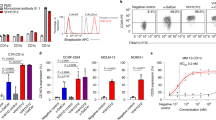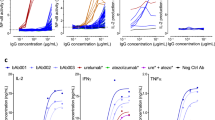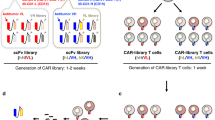Abstract
Anti-CD3 antibodies of some IgG subclasses are very potent T lymphocyte mitogens in vitro and, seemingly contradictorily, very effective immunosuppressive agents in vivo. Using hamster anti-murine CD3 monoclonal antibody, 2C11, as a model, we have found that 2C11.IgG, or its F(ab′)2 fragment, coupled to microbeads can provide short-term and vigorous activation of T cells and expansion of the lymphoid system in vivo. In contrast to free 2C11.IgG, these conjugates do not kill mice and cause T cell depletion, and can enhance immune responses. This study suggests that properly modified anti-CD3 antibodies can serve as in vivo immune system enhancers potentially useful in the treatment of cancer and chronic infectious diseases.
This is a preview of subscription content, access via your institution
Access options
Subscribe to this journal
Receive 12 print issues and online access
$209.00 per year
only $17.42 per issue
Buy this article
- Purchase on Springer Link
- Instant access to full article PDF
Prices may be subject to local taxes which are calculated during checkout
Similar content being viewed by others
References
Coley, W.B. 1909. The treatment of inoperable sarcoma by bacterial toxins (the mixed toxins of the streptococcus of erysipelas and the bacillus prodigiosus). The Practitioner 83: 591–613.
Nauts, H.C., Swift, W.E. and Coley, B.L. 1946. The treatment of malignant tumors by bacterial toxins as developed by the late William B. Coley, M. D., reviewed in the light of modern research. Cancer Res. 6: 205–216.
Old, L.J. 1992. Tumor immunology: the first century. Current Biology 4: 603–607.
Bakker, W., Nijhuis-Heddes, J.M.A. and van der Velde, E.A. 1986. Postoperative intrapleural BCG in lung cancer: a 5-year follow-up report. Cancer Immunol. Immunother. 22: 155–159.
Lamm, D.L. 1985. Bacillus Calmette-Guerin immunotherapy for bladder cancer. J. Urol. 134: 40–47.
Kölmel, K.F., Vehmeyer, K., Göhring, E., Kuhn, B. and Wieding, J.U. 1991. Treatment of advanced malignant melanoma by a pyrogenic bacterial lysate. A pilot study. Onkologie 14: 411–417.
Rosenberg, S.A., Lotze, M.T., Muul, L.M., Chang, A.E., Avis, F.P., Leitman, S., Linehan, W.M., Robertson, C.N., Lee, R.E., Rubin, J.T., Seipp, C.A., Simpson, C.G. and White, D.E. 1987. A progress report on the treatment of 157 patients with advanced cancer using lymphokine-activated killer cells and interleukin-2 or high dose interleukin-2 alone. N. Eng. J. Med. 316: 889–897.
Lienard, D., Ewalenko, P., Delmotte, J.-J., Renard, N. and Lejeune, F.J. 1992. High-dose recombinant tumor necrosis factor alpha in combination with interferon gamma and melphalan in isolation perfusion of the limbs for melanoma and sarcoma. J. Clin. Oncol. 10: 52–60.
Krown, S.E. 1987. Interferon treatment on renal cell carcinoma: Current status and future prospects. Cancer 59: 647–651.
Rosenberg, S.A. and Lotze, M.T. 1988. Cancer immunotherapy using interleukin-2 and interleukin-2-activated lymphocytes. Ann. Rev. Immunol. 4: 681–709.
Rosenberg, S.A., Packard, B.S., Aebersold, P.M., Solomon, D., Topalian, S.L., Toy, S.T., Simon, P., Lotze, M.T., Yang, J.C., Seipp, C.A., Simpson, C., Carter, C., Bock, S., Schwartzentruber, D., Wei, J.P. and White, D.E. 1988. Use of tumor-infiltrating lymphocytes and interleukin-2 in the immunotherapy of patients with metastatic melanoma. N. Eng. J. Med. 319: 1676–1680.
Osband, M.E., Lavin, P.T., Babayan, R.K., Graham, S., Lamm, D.L., Parker, B., Sawczuk, I., Ross, S. and Krane, R.J. 1990. Effect of autolymphocyte therapy on survival and quality of life in patients with metastatic renal-cell carcinoma. Lancet 335: 994–998.
Van Wauwe, J.P., De Mey, J.R. and Goossens, J.G. 1980. OKT3: A monoclonal anti-human T lymphocyte antibody with potent mitogenic properties. J. Immunol. 124: 2708–2713.
Chang, T.W., Kung, P.C., Gingras, S.P. and Goldstein, G. 1981. Does OKT3 monoclonal antibody react with an antigen-recognition structure on human T cells? Proc. Natl. Acad. Sci. USA 78: 1805–1808.
Leo, O., Foo, M., Sachs, D.H., Samelson, L.E. and Bluestone, J.A. 1987. Identification of a monoclonal antibody specific for a murine T3 polypeptide. Proc. Natl. Acad. Sci. USA 84: 1374–1378.
Cosimi, A.B., Colvin, R.B., Burton, R.C., Rubin, R.H., Goldstein, G., Kung, P.C., Hansen, W.P., Delmonico, F.L. and Russell, P.S. 1981. Use of monoclonal antibodies to T-cell subsets for immunologic monitoring and treatment in recipients of renal allografts. N. Eng. J. Med. 305: 308–314.
Thistlewaite Jr., J.R., Stuart, J.K., Mayes, J.T., Gaber, A.O., Woodle, S., Buckingham, M.R. and Stuart, F.P. 1988. Monitoring and complications of monoclonal therapy: Complications and monitoring of OKT3 therapy. Am. J. Kidney Dis. 11: 112–119.
Waldmann, H. 1989. Manipulation of T-cell responses with monoclonal antibodies. Ann. Rev. Immunol. 7: 407–444.
Ortho Multicenter Transplant Study Group. 1985. A randomized clinical trial of OKT3 monoclonal antibody for acute rejection of cadaveric renal transplants. N. Eng. J. Med. 313: 337–342.
Tax, W.J.M., Hermes, F.F.M., Willems, R.W., Capel, P.J.A. and Koene, R.A.P. 1984. Fc receptors for mouse IgG1 on human monocytes: Polymorphism and role in antibody-induced T cell proliferation. J. Immunol. 133: 1185–1189.
Williams, J.M., Deloria, D., Hansen, J.A., Dinarello, C.A., Loertscher, R., Shapiro, H.M. and Strom, T.B. 1985. The events of primary T cell activation can be staged by use of Sepharose-bound anti-T3 (64.1) monoclonal antibody and purified interleukin-1. J. Immunol. 135: 2249–2255.
Geppert, T.D. and Lipsky, P.E. 1987. Accessory cell independent proliferation of human T4 cells stimulated by immobilized monoclonal antibodies to CD3. J. Immunol. 138: 1660–1666.
Ellenhorn, J.D.I., Hirsch, R., Schreiber, H. and Bluestone, J.A. 1988. In vivo administration of anti-CD3 prevents malignant progressor tumor growth. Science 242: 569–571.
Ellenhorn, J.D.I., Schreiber, H. and Bluestone, J.A. 1990. Mechanism of tumor rejection in anti-CD3 monoclonal antibody-treated mice. J. Immunol. 144: 2840–2846.
Kast, W.M., Bluestone, J.A., Heemskerk, M.H.M., Spaargaren, J., Voordouw, A.C., Ellenhorn, J.D.I. and Melief, C.J.M. 1990. Treatment with monoclonal anti-CD3 antibody protects against lethal Sendai virus infection by induction of natural killer cells. J. Immunol. 145: 2254–2259.
Gambacorti-Passerini, C., Hank, J., Surfus, J., Tans, K., Moore, K., Borchert, A., Albertini, M. and Sondel, P.M. 1991. A phase I/b trial of anti-CD3 MAb plus IL2 in patients with cancer. Proc. Am. Asso. Cancer Res. 32: 248.
Yang, S., Branch, C., Grimm, E.A. and Roth, J.A. 1991. Low dose OKT3 prior to IL2 and TNF-α induces and enhances activation of cytotoxic lymphocytes in vivo. Proc. Am. Asso. Cancer Res. 32: 249.
Richards, J.M., Bluestone, J.A., Maimone, D., Ramming, K., Domanski, P.J., Vogelzang, N.J. and Gregory, S.A. 1991. Phase IB evaluation of OKT3. Proc. Am. Asso. Cancer Res. 32: 253.
Sosman, J., Ellis, T., Bodner, B., Kefer, C. and Fisher, R.I. 1992. Phase IB trial of anti-CD3 (OKT3) and low dose continuous infusion (CI) interleukin-2 (IL-2) in cancer patients. Proc. Am. Asso. Cancer Res. 33: 338.
Sun, L.K., Liou, R.S., Sun, N.C., Gossett, L.A., Sun, C., Davis, F.M., MacGlashan, Jr., D.W. and Chang, T.W. 1991. Transfectomas expressing both secreted and membrane-bound forms of chimeric IgE with anti-viral specificity. J. Immunol. 146: 199–205.
Chang, T.W., Davis, F.M., Sun, N.C., Sun, C., MacGlashan, D.W. Jr. and Hamilton, R.G. 1990. Monoclonal antibodies specific for human IgE-producing B Cells: A potential therapeutic for IgE-mediated allergic diseases. Bio/Technology 8: 122–126.
Author information
Authors and Affiliations
Rights and permissions
About this article
Cite this article
Wedrychowski, A., Kim, YW. & Chang, T. Immune Enhancers Composed of Polyvalent Binding Sites of Anti-CD3 Antibodies. Nat Biotechnol 11, 486–489 (1993). https://doi.org/10.1038/nbt0493-486
Received:
Accepted:
Issue Date:
DOI: https://doi.org/10.1038/nbt0493-486



